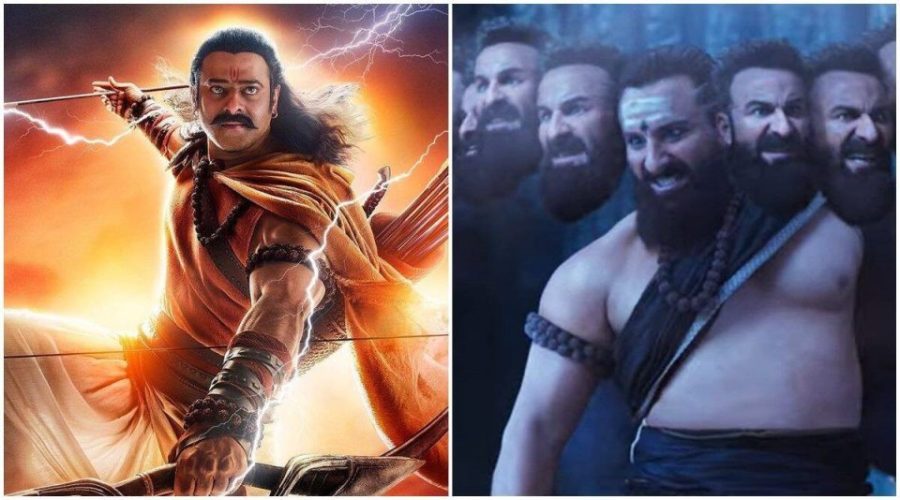
Adipurush review: A flat retelling of India's most famous epic; only Ravana roars

‘Adipurush’ – Bollywood’s most recent adaption of Valmiki’s grand epic falls completely flat as it journeys down a road paying obeisance to the protagonists rather than getting down to telling a spell-binding story in a creative, cinematic fashion.
The makers miss a great opportunity to tell India’s most relatable story on celluloid, and with the help of some shoddy CGI and background music full of ‘Ram Siya Ram, Siya Ram Jai Jai Ram’, (this chant literally plays every few minutes in the first half), the director Om Raut turns ‘Adipurush’ into a paean to Ram, Sita and Hanuman. No character seems real, and they move around in an ethereal way in surreal, idyllic backgrounds. The forest setting particularly seems to have been inspired by ‘Baahubali’.
In ‘Adipurush’, the characters enter the frame only to pose for an image we are all familiar with since childhood – the brave Ram wielding his bow and arrow; a tragic-looking Janaki or Sita pining for Ram in the Ashoka grove in Sri Lanka, (which is strangely decorated with cherry blossoms); the memorable scene when Ram hugs Hanuman; Hanuman kneeling at the feet of Lakshman, Ram and Sita etc, etc.
Om Raut leaves the gods alone in ‘Adipurush’. He is highly reverential while portraying them except for Hanuman who he imbues with a slight spirit of fun. The rest seem like apparitions. The director, however, pours all his creative energy into building up an absolutely devilish Ravana (played by Saif Ali Khan, who is in top form) which then makes him the only character you remember in the film.
Also read: Sirf Ek Bandaa Kaafi Hai review: A riveting courtroom drama about justice for a rape victim
Indian mythology’s most famous antagonist Ravana gets a truly raw deal in ‘Adipurush’. He is this giant-sized, bearded individual clad in dark coloured warrior clothes all the time (at times he suspiciously resembles a Mughal king) and lives in a dark citadel manned by monsters with demonic black bats flying around.
If Ravana is not praying to Lord Shiva, and playing the Aveena before a large-sized lingam till his hands bleed, or tinkering with his sword, he is enjoying what seems like a massage with gigantic snakes crawling all over him. (This is probably Om Raut’s imagination running riot just to show that Ravana was invulnerable to snakes due to a boon from the gods) Ravana is portrayed as being intolerant and evil, much like the Mughal general Udaybhan Rathod in Om Raut’s controversial ‘Tanhaji’, essayed by Saif again.
If only Om Raut had expended his energy on bettering the CGI – the monkeys and the bear Jambavan who help Rama to fight Ravana are amateurishly done. Some of the expressions these monkeys make are positively hilarious.
The first half sets the story in motion as Ravana kidnaps Janaki (Kriti Sanon, who puts up a vapid show), after his sister Surpanaka comes crying to him complaining about Lakshman and Raghava (Ram is called Raghava here). Janaki, who is behind a protective force shield (the new age tech touch) steps out of it to give alms to Ravana dressed as an old sage. And finds herself in Ravana’s aerial vehicle, a mean looking large-sized creature. (Incidentally, for some reason, Ravana also vicariously enjoys watching this creature feast on chunky legs of meat as it hangs upside down in his fortress)
Also read: Scoop review: Hansal Mehta’s subversive take shines light on journalism’s dark side
As he walks into his fortress with a winsome Janaki, Ravana’s wife Mandodari warns of impending disaster and it has nothing to do with jealousy it seems. That’s as much as you get in the form of dialogues. The dialogues in the film are sparse and crass, for example, when Ravana’s son lights up Hanuman’s tail with a cloth, he says, Jali na.. Jiski jalti hai… (it stings doesn’t it, those who are lit burn)
Hanuman replies: Kapda tere baap ka. Tel tere baap ka. Aag bhi tere baap ki. Toh jalegi bhi tere baap ki.(the cloth is your father’s, the oil and fire too, so your father too will burn)
The most entertaining dialogues may be the ones when Ravana’s heads furiously bobbing around converse with each other discussing how he should win the heart of the stubborn, beautiful Sita. Other dialogues seem to be targeted at a particular section of the audience, as Hanuman, after returning from Sri Lanka having set fire to the fortress, tells in a suprisingly threatening tone to Ram and the monkey army – “I showed them how we will burn them if they take our women!”
And Ram (played by a very pained looking Prabhas) also gives a rousing commander-in-chief speech to the monkey army carrying saffron flags before they set off to Sri Lanka to fight, urging them to fight for dharma.
The composes Ajay-Atul, who gave Indian cinema the rousing, upbeat ‘Zingaat’, are not in great form in ‘Adipurush’. Except for the unmissable Jai Siya Ram number, there’s nothing to take home. In the beginning of the movie, the makers of ‘Adipurush’ give a disclaimer that the film is not a scholarly interpretation of the Ramayana. That is evidently true. Can we have our Ramayana back please?

